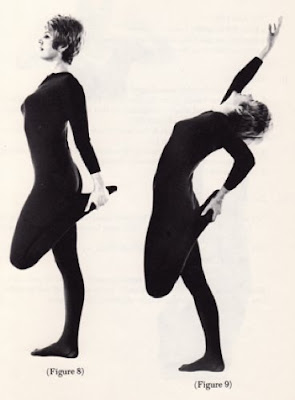Last night, I slept for 10 and a half hours. This is a half hour more than the previous two days and a lot of sleep for someone who ordinarily sleeps for 7. I don't know if I'm fighting a bug, yoga-related exhaustion or if it's just sloth, but I'm going to go with it for now. My body knows what it needs. With the long sleep, the weird, movie-like dreams continue. Last night was a comedy, a kind of dark twisted one. Who needs television when you can just close your eyes?
I ended up doing my yoga practice in the afternoon. Between teaching two classes, I had two solid hours of free time. I worked through the Primary Series and then spent another half-hour experimenting with more hip openers. Hip openers have become my new project. As I biked to my last class of the day, my hips felt all loose and floppy, in a good way!
I did the same sequence I mentioned yesterday, but added standing splits against the wall and a variation (read: modification; since I can't actually do the pose) of Hanumasana. I really worked the low lunge pose, bringing the stretch deep into the hip by extending my back leg behind me and shifting my weight forward toward the front leg, while dropping my pelvis down. I even tried propping my front foot up on a chair, so I could really bring the stretch deep into the hip.
I thought I should offer a clearer explanation of the Supta Virasana psoas stretch I've been using (the one I mentioned yesterday). It's quickly becoming my New Favourite Thing. Here are the basics:
1) Come into Setu Bandha Sarvangasana (Bridge Pose) with a block positioned vertically under the sacrum (or horizontally for less height, if your hips are very tight).
2) Tuck one foot underneath, as you would for Supta Virasana (Reclining Hero's Pose), pressing the knee towards the floor. It likely won't reach the floor. Basically, think of this pose as an elevated Half Supta Virasana.
3) Keep the other foot firmly on the floor. You'll feel the stretch in the quadracep and deep in the hip crease of the tucked leg (you shouldn't feel any pain in your knee though). As the pose deepens, move the toes further toward your armpit and the knee closer to the floor.
4) Repeat on the other side.
As I did my three repetitions of Urdhva Dhanurasana today, I focused specifically on pressing my feet deeply into the floor and using the strength of my legs to shift my weight toward my hands and also lift UP! The hip openers were helpful - I was able to hold the pose longer in each repetition and also gently rock, rock, rock my armpits toward the back wall. I'm not sure if this is really doing anything to open the hips, but it felt good.
Completely an aside, but all of this hip work has done wonderful things for my handstand! I find that I can come up very lightly and today I lifted up and balanced without touching the wall.
I did another video of Sirsasana, this time working against the wall. I shifted my weight forward and back to get a sense of alignment in the pose. The resulting video was VERY revealing. As I suspected, I haven't been straightening my legs completely in headstand, erring on the side of caution because I'm afraid of falling over backward.
The good news is, as much as I was forcing myself to arch back, towards the wall, I never actually touched the wall (I didn't fall over). Tomorrow, I'll take the pose back to the middle of the room and see if I can apply these alignment lessons in context, with a big dose of courage, of course.
More Vintage, 1970s Yoga, this time from Kareen Zebroff (who's actually a pretty cool lady and still teaching yoga):
(On a more serious note, maybe I should add this vintage move to my series of hip openers!)

2 comments:
That looks like a nice prep for natarajasana.
@Susananda: Yes! I haven't come across anything else that stretches the Psoas in quite the same way. I find that if I lower the block way down (almost flat) and place it horizontally under my buttocks, I can do a more intense, quadracep focused Supta Virasana too.
Post a Comment